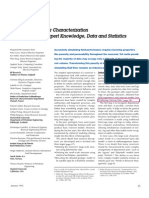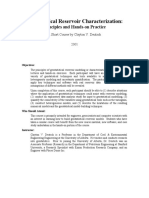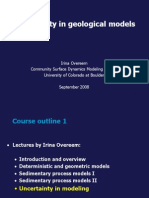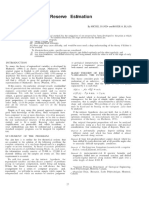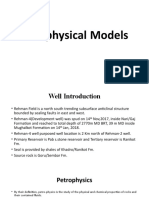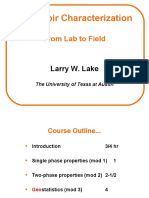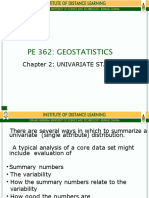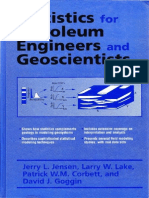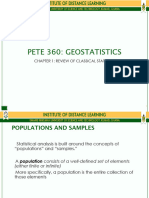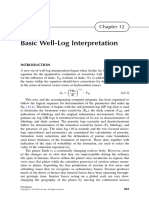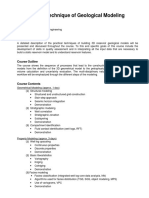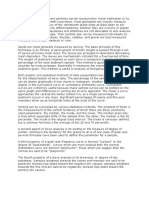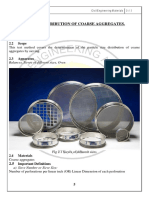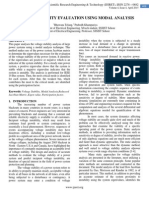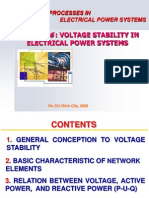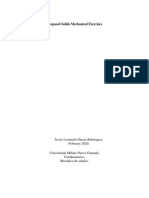Geostatistics for Reservoir Characterization
In this lecture you will The origin of randomness
What is required for randomness to exist The definitions of random, deterministic and stochastic
learn
�Randomness is
behavior of a system or process which produces uncertain results systems may show extreme sensitivity to initial conditions
Such systems have 2 properties
Nonlinear physical law Iterative processes
�Apparently simple mechanical systems can show unpredictable behaviour
The Outcome of a Flipped CoinFig. 1.1
Height of Toss
Rate of Spin
�Examples of Nonlinear Physical Laws
Basic well flow equation
q=
2khP (In(re/rw)+s)
nonlinear in re, rw and s
Two phase fractional flow
fw =
krw(Sw)/w ____ krw(Sw)/w + kro(Sw) /o
nonlinear in krx krx nonlinear in Sw
�Examples of Iterative Processes in Geology
Diagenesis
Growth of clays Leaching Cementation
Deposition
Sedimentation Erosion Breakage
�Sedimentation
�Rock breakage is a non-linear iterative process
1-f0 1-f1
Dpo Dp1 f1
f0
Dp2
...
Dpi = (f0Dp0) x (f1) x (f2) x (f3) x ..
�Systems with well-defined boundary conditions can appear to behave unpredictably
May's Equation
xi+1 = xi(1 - xi)
1.0 0.8 0.6 x 0.4 0.2 0.0 3.5
3.6
3.7
3.8
3.9
4.0
�Summary so far
Randomness = unpredictable For unpredictability, all we need is a process that is
non-linear iterative
�Definitions
Random - Having no predictable aspects Deterministic - Completely predictable Stochastic - Partly predictable, some randomness
�Measurements
Are snap-shots of the reservoir, providing needed values for engineering calculations Have a scale which represents a rock/fluid property over a certain volume V
WELL TESTING
core plug
V = 10-6 m3
WELL LOGGING
V=
10-2
m3
V = 106 m3
May be biased, inaccurate, or misleading
�Example Core Plugs
Core from barrel Approx 30ft sections Incomplete recovery
Gaps - where? How much?
1.2 ft 1.7 ft
Biased sampling
1ft sample spacing? Core photos useful
What does each observation represent?
�Summary so far
Systems can have various amounts of unpredictability
Random Stochastic Deterministic
Need care deciding if a quantity is random
The measurements can fool us The geology might be deterministic (next example!)
�Reservoir Properties and measurements example
9950
Non-linearity and randomness cause variability (e.g., perm k) But deterministic part is also there (can you find it in this example?)
10000
Depth, ft
10050
10100
10150
10200 1 10 100 1000 10000 Plug Permeability, mD
�Reservoir Properties usually have a deterministic component
Lamina-scale (mm to cm) k
Nested scales of variation can make property look very unpredictable Physical laws give some predictability (scales or stratal elements)
Bed-scale (cm to m)
Formation-scale (m to100's m)
�Reservoir Properties and measurements: some details
Stratal element
PARASEQUENCE Thickness (m) Extent (sq. km) Time (yrs)
1
Depending on volume V, measurements
capture some variable & deterministic parts miss out smaller scales
Measurement resolution
10 1 0.1 50 5 0.5 1000
BEDSET
Seismic
BED
Plug
LAMINASET
LAMINA
Probe Thin section
Well log Whole core
�Another example
Changing value with measurement volume V
kh/kv
from Cowan and Bradney, 1997
�Same example (replotted)
Change value with measurement volume V
kv/kh and volume of measurement
1 kv/kh 0.1 0.01
probe plug tester tidal
0.001 0.001
0.1
10
1000
"scale" of msmt, ft
�Summary
Even deterministic systems may exhibit randomness
need iteration need nonlinearity
Measurements
are snap-shots of a reservoir property have a volume (scale), depending on measurement may be wrong/misleading
Reservoir properties
are variable have some systematic elements measurements have to capture both aspects


